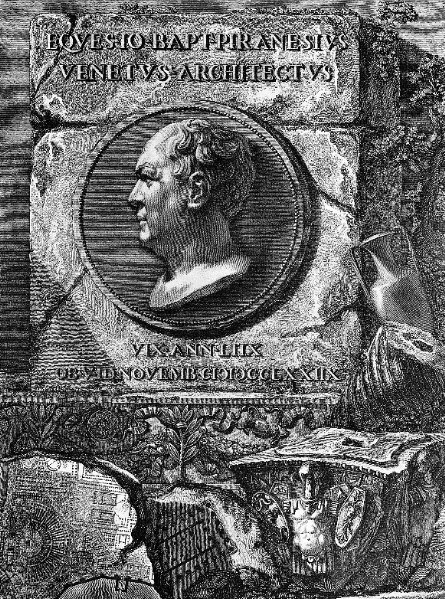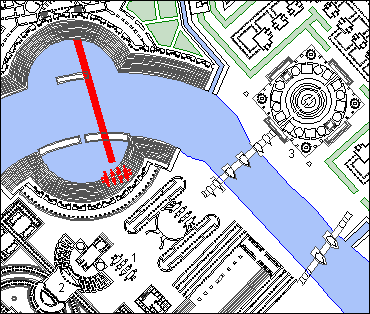the portrait of Piranesi
1998.06.28
There is a portrait of Piranesi engraved by his son Francesco. The portrait is a profile set in a medalion, and the overall composition of the plate is in the Piranesi style. In the lower left corner, there is a stone fragment carved with plans, and it is indeed a fragment of the Ichnographia, specifically the Theater of Marcellus, the Minutia Vetus, and the Porticus Octavae. ...wonder if Francesco, or even Piranesi himself, saw the Ichnographia as Piranesi's greatest achievement. The four-sided Temple of Janus is also clearly delineated on the fragment.
...a case for the father-son theme that begins with Mars and Romulus (inversely God, the Father and His Son Jesus), and could include Augustus and Agrippa, and Trajan and Hadrian, and even Theodosius and Honorius.


Ichnographia Campus Martius
1998.07.12
Piranesi's Ichnographia Campus Martius is a "text" of multiple historical accounts delivered through the combination of two languages. The Ichnographia tells the story of Rome when it was the capital of the ancient Western world. The story begins with Romulus leading the first triumphal march, and ends with the burial of the Emperor Honorius almost 1200 years later. Piranesi relates this urban history through a sequence of dual narratives--life and death, love and war, the profane and the sacred--which signify the continual theme of inversion and occasionally incorporate satire. Piranesi communicates this vast classical treatise through Latin labels which identify the individual buildings within the Ichnographia, and, most often, the written word requires a reading in tandem with the ichnography to grasp the full extent of Piranesi's copious message. This unique aggregate language of word and image, moreover, readily affords a syntax where double meanings are not uncommon, and, hence, befits Piranesi's dual narratives of inversion and satire perfectly.
Stephen Lauf
| |
Honorius, Flavius
1998.07.17
- son of the emperor Theodosius I, and brother of Arcadius
- the first emperor of the western Roman empire
The emperor Honorius plays a significant role within the narrative of the Ichnographia in that his sepulcher is the last building of ancient Rome represented in the large plan. With the exception of the Arch of Arcadius, Honorius and Theodosius (which is not represented within the Ichnographia), all of Honorius' other building activities in Rome involved repairs to existing structures. Indeed, Honorius is the last Roman emporer to build imperial structures in Rome.
In broad terms, the reign of Honorius signifies the Roman Empire's cessation as a cohesive whole, as well as Rome's ceasing to be the nucleus of classical civilization. Furthermore, Honorius' new constructions in Rome denote a clear shift in focus directed away from the Roman Forum and aimed at the Basilica of St. Peter in the Vatican valley--a shift that reflects perfectly Rome's inversion from paganism to Christianity.
Building Activity in Rome
Valentinian II, Theodosius I, and Arcadius begin, and Honorius completes, S. Paolo fuori-le-mura (384-402/3).
Honorius in about 401-2 greatly improved [the walls] of Rome.
. . . in 395/402 Arcadius and Honorius restored the theatre of Pompey, and in 398/9 Honorius repaired one of the Anio aqueducts with money captured in the campaign against Gildo.
. . . in c.400 Honorius built a large mausoleum for himself and his family beside [St.Peter's].
. . . in 405, after the victory of Pollentia, Arcadius, Honorius, and Theodosius built their main victory monument at one end of the Pons Neronianus (the other bridge linking the city to the Vatican area), whereas in the Forum they erected only statues to celebrate this victory and that over Gildo in 398.
Bryan Ward-Perkins, From Classical Antiquity to the Middle Ages - Urban Public Building in Northern and Central Italy AD 300-850 (New York: Oxford University Press, 1984).
Arch of Arcadius, Honorius and Theodosius
This arch was erected in 403 A.D. by Arcadius, Honorius, and Theodosius, in honor of Stilicho's victories. It was certainly near the Arch of Gratian, Valentinian and Theodosius, but whether it spanned the same street or a branch a short distance to the south, we do not know. This branch led from the porticus Maximae [or Porticus Gratian, Valentinian and Theodosius] to the pons Neronianus.
Samuel Ball Platner, The Topography and Monuments of Ancient Rome (Boston: Allyn and Bacon, 1904), pp. 359.

The approximate positions of the Pons Neronianus and the Arch of Arcadius, Honorius and Theodosius are indicated in red and superimpose the area of the Ichnographia around the bend in the Tiber and Hadrian's Tomb.
1. Arcus Gratiani, Valentiniani et Theodosii, 2. Porticus Gratiani, Valentiniai et Theodosii, 3. Sepulchrum Hadriani.
Sep. Honorij Imp.
1998.07.17
Re: lack of life
2002.01.19 11:46
...to learn more of Honorius (the younger son of Theodosius who is now Emperor of the West) and his wife Maria. Honorius was the last ancient ruler to [re]build the walls of Rome (because of the "Gothic Wars" -- Christian "Goths" that is) and he also built an imperial mausoleum attached to the original Basilica of St. Peter's. Sometime in the 1500s the sarcophagus of Maria was discovered (very likely while the old basilica was being demolished to make way for the new/present one). The sarcophagus of Maria may well be the last substantial imperial artifact of (the city of) Rome, and after an illustrious title page and a frontispiece, it is an image of the sarcophagus of Maria that Piranesi uses to begin his Campo Marzio publication. In a most elegantly covert way, Piranesi began the 'history' of the Campo Marzio with what is really it's ending, and what is probably the world's greatest designed architectural inversionary double theater goes on from there.
Maria, wife of the emperor Honorius...
2002.02.21
|